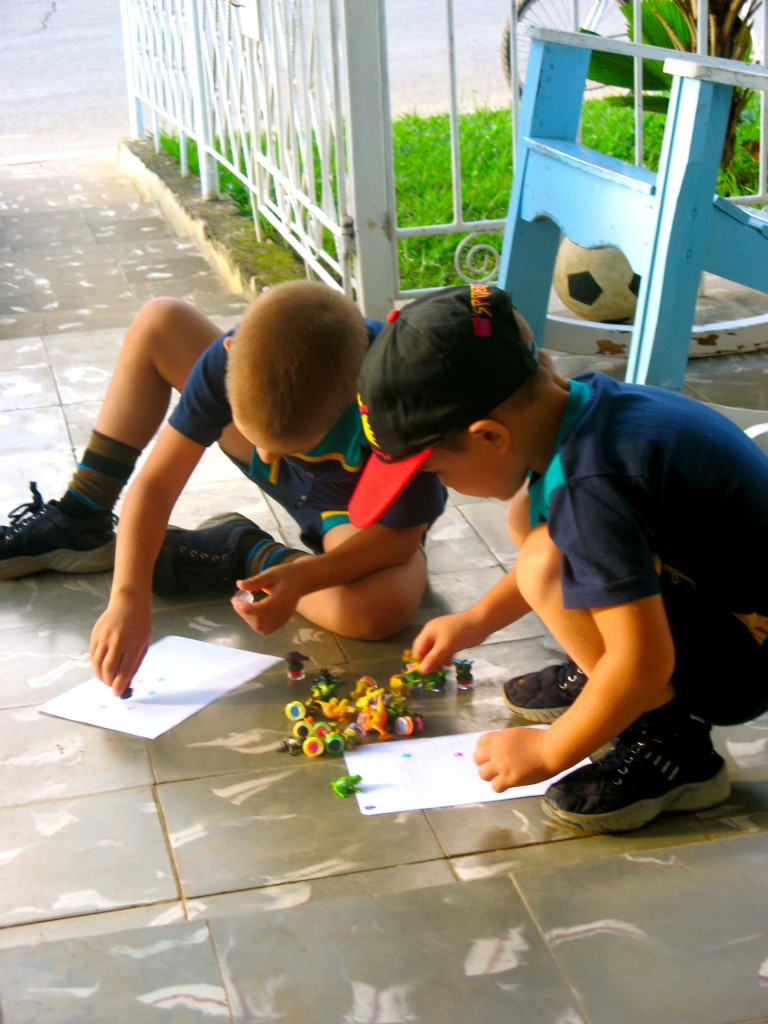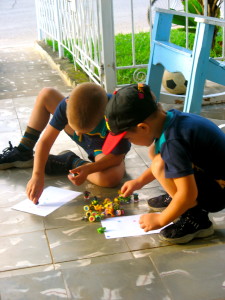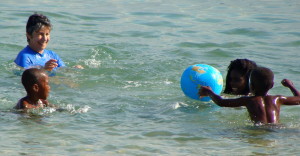

I love kids. I always have. In 2005, as I was preparing for a year of unstructured global travel, the manager of a Berkeley travel store made a wonderful suggestion: “Take along an inflatable globe.”
I knew I would be living with some families during my year of solo travel and I knew I’d enjoy connecting with children. The globe suggestion sparked the idea of preparing a “kid kit” for playing with children of various ages during my sabbatical in Latin America and Asia. Since I am less than five feet tall, it was important that my kid-kit not weigh too much or take up much room in luggage already stuffed with gifts for host families, prescription meds, clothing for various climates and swim and snorkel gear.
Here is what I chose for my kid-kit:
- An inflatable globe;
- Two soft green Velcro frog mitts with three round Velcro “bugs” for playing catch;
- A dozen tiny self-inking stamps (like the ones primary school teachers use to stamp good papers) with images of animals, insects and flowers;
- A bag full of plastic dinosaurs and frogs;
- A copy of Herman the Helper, a simple picture book in English with colorful illustrations;
- A seven-inch ugly bug finger puppet.
These items took up remarkably little room in my daypack and engaged children in joyful play on several continents. In Guatemala I met nine-year old Luis who lived with his mother in the hostel that I made my base for travels around the country. We soon invented “globo-futbal” each evening we’d kick the globe around the halls and lounge of the hostel in a loose approximation of soccer. Over my two-month stay in Guatemala, this and other games created a bond so firm that Luis and his mom have become “chosen kin.” Nearly a decade later, we still email and I have returned periodically to see how he progresses through adolescence.
In Costa Rica, the little plastic frogs provided unintended play therapy for a delightful three-year old whose mother (my conversation partner in a language immersion program) has an absolute terror of frogs. Paola was initially unsure if it was OK for her to play with the frogs and she kept looking at her mother for her reaction. But Mom was brave and soon the child was happily hopping the little ranas around the floor, while in her sweet high voice she carried on a continuous banter in Spanish between the frogs and dinosaurs.

In Vinales, Cuba, I stayed with a family whose four and six-year old boys loved playing soccer on the veranda with the globe and enjoyed doing art projects with the little stampers. Whereas the six-year old was a very focused child, the four-year old was extremely active and distractible and sometimes a handful. But as soon as he picked up the little self-inking stampers, he became an intensely focused artist. He would make patterns with the stamps, using color and position to create marvelous compositions. I began setting aside time to do art with him every day, garnering his mom a bit of respite during the two weeks that I lived with their family.
I have continued to carry my kid-kit whenever I travel internationally. In 2011, I was sitting in a large, dingy waiting area of the airport in Addis Ababa, Ethiopia. It was close to midnight and I was surrounded by throngs of Moslem adults and children waiting for a flight to Riyadh, Saudi Arabia. The tired, restless children several rows in front of me kept turning around to watch, staring and staring at my white face and my flagrantly uncovered grey head. I eventually grew uncomfortable being the object of their curious attention and decided on a better way to amuse them. Reaching into my pack I took out the lightening bug finger puppet. It was about seven inches long and incredibly ugly. It had a brown leather face with protruding bug-eyes, a black fuzzy thorax, gauzy sheer wings, and a long transparent green tube of a tail with an LED light in its butt. Putting it on my finger, I slowly, slowly made it creep up the back of the seat in front of me. As the bug crested the back of the seat, I straightened out my finger, which caused the bug butt to glow bright psychedelic green.
The half dozen kids who had been watching me grew bug-eyed themselves. Over the next fifteen minutes, as the bug lit up and pranced over the top of the seats, black-robed mothers smiled, dozens of other children began pointing and laughing, and some of the braver boys came over to touch the bug. With some encouragement, they stopped hitting it and took turns stroking it gently. Soon a circle of eager young kids had come close enough to ask my name and tell me theirs – “Suleiman,” “Ahmed,” “Mohammed” – each one shaking hands as he or she made their introduction. By the time the flight to Riyadh was called, the waiting area was a sea of smiles, and the children departed in a chorus of “Goodbye,” “Bye-bye” – probably the full extent of our mutually overlapping language.
I love kids. I’ve always known that. But traveling on my own for a year showed me something important. One of my reasons for taking this sabbatical journey was to look around with fresh eyes in hopes of seeing how I might want to invest my energies in my later years. The experience of sharing my kid-kit with children and engaging them in play was one of the most joyful, memorable and satisfying parts of my trip. Furthermore, many of my best photos are portraits of young children and their parents. Looking at where I tended to point my camera during that year of travel helped me recognize that being around young children is one of my true passions in life. And surely the world can use a global grandma.

(You can see my photos of children and their parents in the album on this site.)
